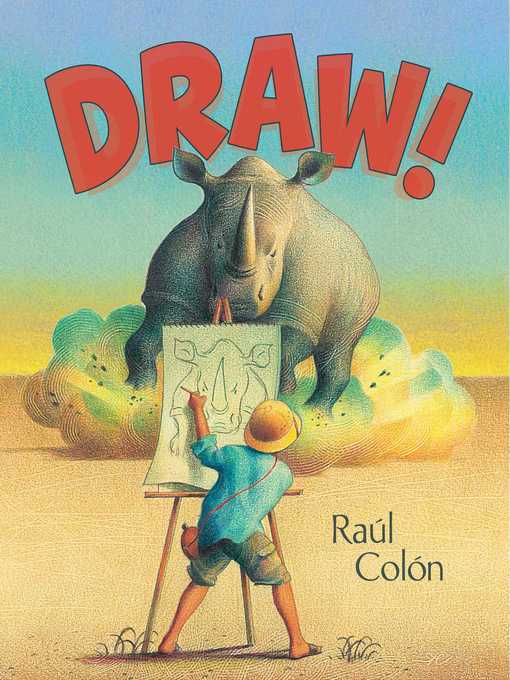
Draw!
کتاب های مرتبط
- اطلاعات
- نقد و بررسی
- دیدگاه کاربران
نقد و بررسی

Starred review from June 23, 2014
In Colón’s (Baseball Is...) wordless fantasy, a boy lies on his bed, his sketchbook on the floor; he’s lost in a large book titled Africa. As he takes up his sketchbook and begins to draw, small full-color panels of himself setting off across the African veldt sail forth from his mind like thought balloons. On the next page, he’s entered his fantasy fully; he’s in the African grasslands, carrying his drawing supplies and waving to a nearby elephant. After obligingly allowing its portrait to be drawn, the elephant carries the boy to meet other animals who pose for him—zebras, giraffes, and hippos. A rhinoceros portrait ends in near-calamity; a gang of baboons draw the boy. After a tender goodbye to the elephant, another series of sunlit panels retreats into the boy’s head as he returns to real life. Colón’s visual signature is the use of finely combed lines to trace the contours of his figures, a technique that’s at once delicate and sensuous. It’s a strongly developed and executed account of a childhood fantasy, urging all young artists to dream and to draw. Ages 4–8. Agency: Morgan Gaynin Inc.

Starred review from August 1, 2014
A wordless picture book celebrates the power of art and imagination. A little boy reads about Africa and then creates his own adventures with his pencils and paints. Wordless books require readers to slow down and read the pictures, and careful children will see beyond the main storyline by looking at the whole illustration. Why is the boy in bed and not outside? The inhaler and bottle of medicine on the side table are hints. But binoculars and an umbrella on the other side of the table tell them that he is not always bedridden. As he draws, he falls deeply into the rich world of his imaginary Africa. First he draws an elephant, and then he rides away on it. He paints zebras, has a sandwich for lunch, records a giraffe stampede and shares one of his many other sandwiches with the gorillas. After a hair-raising encounter with an aggressive rhino, the little artist shares his pencils and food with other primates, who return the favor and sketch him. Colon's signature scratched-watercolor technique adds richness and emotion to this warm story, but it's the framing scenes at beginning and end that really sparkle here. Simple line-and-color washes put the young man at the center of the story and help readers identify with him. Young artists, reach for your sketchbooks. (Picture book. 4-8)
COPYRIGHT(2014) Kirkus Reviews, ALL RIGHTS RESERVED.

Starred review from June 1, 2014
PreS-Gr 3-Using watercolor and colored pencils, Colon has created a wordless book (based on his childhood) that speaks volumes. A boy, home for the day perhaps because of an illness, sits on his bed reading a book about Africa. He begins to draw. Five identical, intensely colored pictures of the boy with an easel, art supplies, and a pit helmet increase in size as readers begin this richly imagined day on a safari. He draws an elephant as an egret watches, and atop the elephant's back, the boy and bird find a herd of zebras. They pose for him as he sits on a stump. Giraffes thunder by, raising clouds of golden dust. The boy draws them, his body aslant as his eyes follow them. He draws a gorilla, who holds his helmet and shares his sandwich. He draws lions, a water buffalo, and a hippo before sighting a charging rhinoceros. Running with all his might, he barely escapes the rhino. Baboons retrieve his pencils, set up his easel, and draw him. They also eat his sandwiches as the day slides into evening. A spread poignantly captures the parting of boy and elephant. Eyes closed, he lays his head against his friend's side while the elephant's trunk gently caresses the boy's cheek. As six identical paintings decrease in size, the book returns to the boy's pale room, now strewn with drawings. The final scene shows the boy at school, holding the elephant's picture front and center. The pleasure the boy takes in making and sharing his art is palpable. Young artists will love this book, as will all children who know the joy of exploring their own imaginations. A must-have for every library.-Mary Jean Smith, formerly at Southside Elementary School, Lebanon, TN
Copyright 2014 School Library Journal, LLC Used with permission.

August 1, 2014
Preschool-K A boy in bed, asthma inhaler within reach, sketchbook at his side, looking at a book about Africa, is not confined by the walls of his room. As he begins to draw, he takes a journey. The palette changes from subdued pen-and-ink with wash in the bedroom to vibrant hues textured with scratched-in lines that seem to pulse, capturing the landscape and animals of Africa. On this wordless art safari, based on Coln's own childhood imaginings, first up is the elephant. This fellow is so pleased with the boy's portrait of him that he then accompanies the boy on his hunt. They spot a zeal of zebras (one watches as the boy creates) and a pride of lions. A charging rhinoceros is calmed when shown a sketch of himselfmade just in the nick of time! Youngsters will pore over each spread in wonder, soaking up the details. Upon his return, the traveling artist shares his pictures with his classmates. A true celebration of where our imaginations can take us.(Reprinted with permission of Booklist, copyright 2014, American Library Association.)

























دیدگاه کاربران